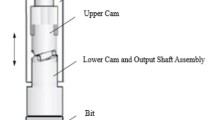As one of the most advanced international drilling technologies at present, rotary steering has been extensively applied to large-displacement, long-distance horizontal, and complex structural wells with numerous advantages, such as strong steering deflecting capacity and good borehole quality. Push-the-bit rotary steering is nowadays commercially applied on a large scale. In the bottom hole assembly (BHA) design of push-the-bot rotary steering drilling, flexible pup joints are the main components that exert an important effect on the exertion of steering deflecting capacity of push-the-bit rotary steering tools. The effect of flexible pup joints on steering capacity of BHA used in the push-the-bit rotary steering drilling process was investigated through a finite element analysis and their action laws were summarized. The results indicated that in order to optimize the deflecting capacity of rotary steering drilling tools, flexible pup joints should be installed cooperatively so as to obtain greater steering drilling capacity. In the rotary steering drilling process, as the outer diameter of flexible pup joints increased, the maximum stress of the BHA decreased. Side cutting force of the drill would increase with the length of pup joints, but this would result in degradation of anti-torsion performance of the BHA.




Similar content being viewed by others
References
Zhang Shaohuai, “New progress and development direction of modern steering drilling techniques,” Acta Pet. Sin., 24(3), 82-83 (2003).
Wang Peng, Sheng Limin, Don Xiurong, and Tang Xueping, “The latest technological progress and development trend of rotary guidance abroad,” Drill. Prod. Technol., 36(06), 32-35 (2013).
Xue Qilong, Ding Qingshan, and Huanglei Lei, “The latest progress and development trend of rotary steering drilling technology,” China Pet. Mach., 41(07), 1-6 (2013).
Tengfei Sun, Hui Zhang, and Deli Gao, “Calculation of the open-hole extended-reach limit for an extended-reach well,” Chem. Technol Fuels Oils, 52(2), 211-217 (2016).
Tengfei Sun, Deli Geo, Hui Zhang, Shujie Liu, and Yanfeng Cao, “The application of artificial fish swarm algorithm in the optimization of trajectory,” Chem. Thehnol. Fuels Oils, 55(2), 61-64 (2019).
Li Jun, Hui Zhang, Tengfei Sun, Zhanwei Song, and Deli Gao, “A novel horizontal well trajectory optimization design method based on particle swarm optimization and analytic hierarchy process,” Chem. Technol. Fuels Oils, 55(1)65-67 (2019).
Tengfei Sun, Deli Gao, and Hui Zhang, “Anew well profile design method for extended-reach drilling,” CMES-Comput. Model. Eng. Sci.. 90(1) , 3745 (2013).
Tengfei Sun, Hui Mang, Liu Shujie, and Cao Yanfeng, “Application of artificial fish swarm algorithm in sohing multiobjective optimization,” Chem. Technol. Fuels Oils, 53(4), 541-547 (2017).
M.A. Colebrook, S.R.Peach, and F.M. Allen, “Application of steerable rotary drilling technology to drill extended reach wells,” IADS/SPE 39327, 1-11 (1998).
Jiang Wei, Jiang Shiquan, and Fuxin Sheng “Application of rotary steering drilling technology and its research progress,”Nat. Gas Ind., 33(04), 75-79 (2013).
E. Biscaro, J.D. D’Alessandro, A. Moreno, M. Hahn, R. Lamborn, M. H. Al-Naabi, and A.C. Bowser, “New rotary steerable drilling system delivers extensive formation evaluation for high build rate wells," SPE Western Regional Meeting / SPE 174016 (2015).
Wang Mingjie, Diqin Peng, and Wangwen Chang, “Influences of flexible joints on guiding force characteristics of RSBHA,” Drill. Prod. Technol., 35(1), 52-55 (2012).
Diqin Feng, Wang Mingjie, Hu Yibao, Zhao Yudong, Zhu Weiping, and Wangwen Chang, “Effect of flex sub’s position on bottom hole assembly with rotary steering tool,” J. China Pet. Nat. Sci. Ed.), 36(05), 84-88 (2012).
Wang Zheng, Gum Zhichuan, Shi Yucai et al., “Analysis of the influence of flexible joint on the inclination ability of push-the-bit rotary steeling bottom-hole assembly,” Drill. Prod. Technol., 41(06), 19-22 (2018).
Li Jun, Lidong Chun, Zhang Hui and Wang Zhao, “Study on influencing factors of deflecting ability of push-the-bit rotary steering tool,” Oil Drill. Prod. Technol., 27(2), 1-12 (2005).
H. Wang, Z.C. Guan, Y.C. Shi, and D.Y. Liang, “Study on build up rate of push the bit rotary steerable bottom hole assembly,” J. Appl. Sci. Eng., 20( 3) 401-408 (2017).
Tang Xueping, Su Yinao, Ge Yunhua, et al., “BHA mechanical analysis for rotary steering drilling system, Mech. Eng., 35( 1), 55-59 (2013).
Xia Yan, Guan Zhichuan, and Shi Yucai, “Evaluation method of parameters design for bottom hole assembly,” J. China Unit. Pet. (Nat. Sci. Ed), 29(4), 48-51 (2005).
Lin Han, “Research on Optimization and Safety Evaluation of Drilling Tools in Ultra Deep Wells,” Yangtze University, China, 2018.
Author information
Authors and Affiliations
Additional information
Translated from Khamiya i Tekhnologiya Topliv i Masel, No. 2, pp. 61— 64, March—April, 2020.
Rights and permissions
About this article
Cite this article
Yantao, B., Gonghui, L., Ghua, D. et al. Finite Element Analysis of Effect of Flexible Pupjoints on Push-the-Bit Rotary Steering Deflecting Force. Chem Technol Fuels Oils 56, 218–225 (2020). https://doi.org/10.1007/s10553-020-01132-8
Published:
Issue Date:
DOI: https://doi.org/10.1007/s10553-020-01132-8




